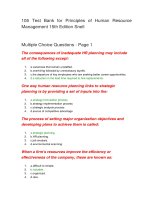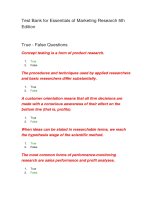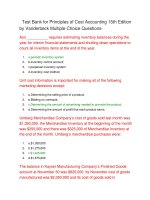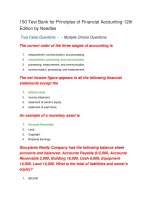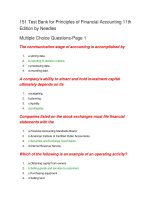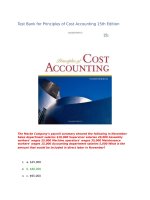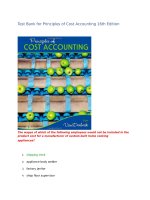Download test bank for principles of human physiology 5th edition by stanfield
Bạn đang xem bản rút gọn của tài liệu. Xem và tải ngay bản đầy đủ của tài liệu tại đây (331.72 KB, 28 trang )
Test Bank for Principles of Human Physiology 5th Edition by Stanfield
Chapter 1
1) The smallest living units capable of carrying out their own basic life functions are
called
A) cells.
B)
organelles.
C)
organs.
D)
organ systems.
E)
tissues.
Answer: A
2)
Cells are classified into which of the following four broad categories?
A) squamous, cubodial, columnar, and basement membranes
B) endocrine, nervous, integumentary, and reproductive
C) atoms, tissues, organs, and organ systems
D) neurons, muscle, epithelial, and
connective tissue
E) skeletal, cardiac, endocrine, and
nervous
Answer: D
3)
Epithelial cells are associated with a noncellular material called a(n)
A) muscle fiber.
B)
endocrine gland.
C)
basement membrane.
D)
connective tissue.
E)
fibroblast.
Answer: C
1
4)
________ are found in the linings of hollow organs where they separate fluids in
the interior cavity from the surrounding body fluids. The interior cavity of a hollow
organ or vessel is known as a ________.
A) Epithelial : lumen
B)
Endocrine cells : lumen
C)
Elastin cells : cavity
D)
Smooth muscle cells : cavity
E)
Connective tissues : basement membrane Answer: A
5)
The tissue type that generates mechanical force and movement, and whose activity
is controlled both on a voluntary and involuntary level, is ________ tissue.
A) nervous
B) epithelial
C) skeletal
D) muscle
E) connective
Answer: D
6)
Glands are derived from what type of tissue?
A) connective
B) reticular
C) nerve
D) muscle
E) epithelial
Answer: E
7) The cell types blood, bone, fat, and lymph would be categorized into which of the
following major cell classes?
A) muscle cells
B) epithelial cells
C) endocrine cells
D) neurons
E) connective tissue cells
Answer: E
2
8)
Which tissue type includes cells contained in an extracellular matrix composed of
collagen and elastin?
A) muscle tissue
B) nervous tissue
C) endocrine tissue
D) epithelial tissue
E) connective tissue
Answer: E
9)
What is a general name for the noncellular material that holds the widely scattered
cells of connective tissue together?
A)
intracellular matrix
B)
extracellular matrix
C)
basement membrane
D)
elastin
E)
collagen
Answer: B
10) Which
of the following is a protein found in connective tissue that provides the
tensile strength to resist stretching?
A) erythropoietin
B) elastin
C) vimentin
D) collagen
E) basement membrane
Answer: D
11) What
are the structures that attach bone to muscle?
A) aponeuroses
B) intracellular matrix proteins
C) ligaments
D) extracellular matrix proteins
E) tendons
3
Answer: E
12) Organs
of the body are defined as
A) a collection of cells that function independently of one another.
B) a collection of cells that perform similar functions.
C) a collection of tissues that function independently of one another.
D) two or more tissues combined to form a structure that allows each tissue to
function independently.
E) a combination of two or more tissues that make up a structure which performs
a specific function.
Answer: E
13) Which of the following accurately represents the order of complexity for the
components of the body, from least to most complex?
A) cells, tissues, organ systems, organs
B) cells, tissues, organs, organ systems
C) organ systems, organs, tissues, cells
D) tissues, cells, organs, organ systems
E) organ systems, cells, tissues, organs
Answer: B
14) The
uptake of nutrients across the epithelial cells of the gastrointestinal tract and
into the bloodstream is called
A) secretion.
B) filtration.
C) reabsorption.
D) absorption.
E) excretion.
Answer: D
15) What
organ system includes the pituitary gland, adrenal gland, and thyroid gland?
A) nervous
B) immune
C) endocrine
D) integumentary
4
E)
cardiovascular
Answer: C
16) The
lumen of which of the following systems is part of the internal environment?
A)
respiratory system
B)
gastrointestinal system
C)
urinary system
D)
cardiovascular system
E)
gastrointestinal and urinary systems
Answer: D
17) The
process whereby fluid from the bloodstream enters the tubules of the kidneys is
called
A) excretion.
B) absorption.
C) filtration.
D) secretion.
E) reabsorption.
Answer: C
18) The
process whereby fluid in the kidneys is transported from the tubules back into
the bloodstream is called
A) absorption.
B) reabsorption.
C) secretion.
D) excretion.
E) filtration.
Answer: B
19) Referring to a membrane as "selectively permeable" describes its ability to
A) allow the movement of particular molecules across a membrane.
B)
restrict only the movement of sodium across a membrane.
C)
restrict only the movement of potassium across the membrane.
5
D)
E)
provide a barrier that restricts the movement of all molecules across a
membrane.
provide a minimal barrier that allows almost any molecule to move
across a membrane.
Answer: A
20) Extracellular
fluid is composed of
A) plasma and intracellular fluid.
B) intracellular fluid only.
C) interstitial fluid and plasma.
D) plasma only.
E) interstitial fluid only.
Answer: C
21) Total
body water is composed of
A) extracellular fluid only.
B) intracellular and interstitial fluid.
C)
intracellular and extracellular fluid.
D)
intracellular fluid only.
E)
plasma and intracellular fluid.
Answer: C
22) Where
is most of our total body water located?
A) in the lumen of the kidneys
B) surrounding the cells
C)
in blood
D)
inside cells
E)
in the lumen of the gastrointestinal tract
Answer: D
23) Which
of the following compartments contain most of the water found in the
human body?
A) plasma
6
intracellular fluid
C) interstitial fluid
D) lumen of the
intestinal tract
B)
E) extracellular fluid
Answer: B
24) What
are the two extracellular fluid compartments of the body?
A) intracellular fluid and blood
B) intracellular fluid and interstitial fluid
C) intracellular fluid and plasma
D) interstitial fluid and blood
E) interstitial fluid and plasma
Answer: E
25) The portion of body water outside of cells that bathes most cells of the body is
called
A) interstitial fluid.
B) extracellular fluid.
C)
intracellular fluid.
D)
plasma.
E)
intercellular fluid.
Answer: A
26) The
fluid compartment with a high sodium and protein concentration is called
A) intracellular and extracellular fluids.
B)
intracellular fluid.
C)
extracellular fluid.
D)
interstitial fluid.
E)
plasma.
Answer: E
27) Which
of the following best describes intracellular fluid?
A) rich in sodium, potassium, and chloride
7
B) rich in potassium and chloride
C) rich in proteins and chloride
D) rich in proteins and
potassium
E) rich in sodium and
chloride Answer: D
28) The
fluid compartment with a high sodium concentration that contains only trace
amounts of protein is called
A) interstitial fluid.
B)
intracellular and extracellular fluids.
C)
extracellular fluid.
D)
plasma.
E)
intracellular fluid.
Answer: A
29) For
a person weighing 150 pounds, how many liters of water are contained in all of
the body's compartments?
A) 11 B) 42 C) 50 D) 14
E) 70
Answer: B
30) Homeostasis
is a term which describes the process whereby the body
A) maintains a variable internal environment.
B) affects the external environment.
C) maintains a constant external environment.
D) maintains a constant internal and external environment.
E) maintains a constant internal environment.
Answer: E
31) Of the following conditions associated with excess heat, which is the most serious
condition?
A) excessive sweating
B) dehydration
C) C) dizziness
8
D)
E)
heat exhaustion
heat stroke
Answer: E
32) The
maintenance of a stable internal environment compatible for life is called
A) biochemistry.
B)
anatomy.
C)
microbiology.
D)
physiology.
E)
homeostasis.
Answer: E
33) What
is the primary mechanism for maintaining homeostasis?
A) intrinsic control
B) extrinsic control
C) inherent control
D) negative feedback
E) positive feedback
Answer: D
34) Which
of the following statements about homeostasis is FALSE?
A)
Homeostasis is the maintenance of the internal environment.
B)
The organ systems work together to maintain homeostasis.
C)
The extracellular fluid is maintained in a state compatible for life.
D)
The primary mechanism to maintain homeostasis is positive feedback.
E)
Illness can result if homeostasis is disrupted.
Answer: D
35) Changes
in the external environment alter the ________, which is detected by the
________, and that information is sent to the integrator.
A) sensor : regulated variable
B) set point : regulated variable
9
error signal : regulated variable
D) regulated variable : set point
C)
E) regulated variable : sensor
Answer: E
36) Lisinopril is a medication that lowers high blood pressure back to within a desired
range of function. The action of this medication is similar to that of a(n) ________ in
the human body.
A) negative feedback response
B) regulated variable
C) positive feedback response
D) set point
E) integrating center
Answer: A
37) If you were to take the temperature of everyone in class, assuming no one is sick,
you would find that not everyone has a temperature of 98.6°F. Which statement
below best explains your findings?
A) If the subject is not at 98.6°F then he or she is in a disease state
B) An error signal has occurred and a positive feedback response has put the
persons in question out of the normal range of function.
C) The measuring instrument is not working properly; everyone has a set point of
98.6°F.
D) Their temperature is no doubt higher than 98.6°F because a positive feedback
loop has increased the subjects' metabolism.
E) Most regulated variables, such as temperature, fluctuate continuously and
oscillate about the set point due to negative feedback control.
Answer: E
38) When
people cut themselves, they have clotting factors in their blood that will be
released continuously in a cascade until their blood clots and terminates the
bleeding. What mechanism caused their blood to clot?
A) secretion
B) reabsorption
C) negative feedback control
D) positive feedback control
10
E)
homeostasis
Answer: D
39) A
________ detects a change in a regulated variable and sends that information to
a(n) ________ which relays signals to a(n) ________, usually a muscle or a gland.
A) receptor : stimulus : regulated variable
B) stimulus : receptor : organ system
C)
sensor : integrating center : effector
D)
sensor : effector : integrating center
E)
receptor : integrating center : negative feedback control
Answer: C
40) Vinnie
has high blood glucose and must take insulin shots to control his blood sugar.
Why must he override his normal homeostatic mechanisms by taking medication?
A) Vinnie's set point has changed telling him he needs more sugar.
B) Vinnie's positive feedback controls are not functioning properly.
C) Vinnie's negative feedback controls are not functioning properly.
D) Vinnie's sensors are detecting high levels of glucose and therefore are not
secreting insulin due to positive feedback control.
E) An error signal has been sent to Vinnie's integrating center, which is not
functioning properly.
Answer: C
41) A
patient has a high salt or sodium intake which draws fluid out of his cells to dilute
the sodium. This process occurs as a result of
A) excretion.
negative feedback control.
C) absorption.
D) positive feedback control.
E) reabsorption.
B)
Answer: B
42) The process of maintaining the internal environment in a state compatible for life is
called ________, and it occurs primarily through ________.
11
homeostasis : negative feedback
B) negative feedback : intrinsic control
C) positive feedback : intrinsic control
D) intrinsic control : negative
feedback
A)
E) intrinsic control :
homeostasis
Answer: A
43) Which
of the following is an example of negative feedback?
A) At the time of birth, uterine contractions push the baby toward the cervix.
Receptors in the cervix detect the pressure caused by the baby and cause the
release of a hormone called oxytocin. This hormone stimulates stronger uterine
contractions, which push more on the baby, causing an increase in pressure and
another increase in oxytocin. The cycle continues until the baby is delivered from
the mother.
B) During a blood clot, platelets release ADP, which stimulates platelet
aggregation, causing platelets to release more ADP.
C) During an infection, the body temperature set point is increased. The
hypothalamus communicates to skeletal muscles to shiver and to blood vessels to
decrease blood flow to the skin, causing a rise in body temperature.
D) Consumption of caffeine increases urine output, causing dehydration.
E) If blood pressure increases above normal, baroreceptors in major arteries
detect the change and send signals to the brain. Certain areas of the brain then
send signals to the nerves that control the heart and blood vessels to make the
heart beat slower and the blood vessels increase in diameter, which in turn
reduce the blood pressure.
Answer: E
44) Luteinizing
hormone-mediated regulation of estrogen during ovulation in women is
an example of
A) a quasi-positive feedback loop.
B)
a quasi-negative feedback loop.
12
C)
D)
E)
both a positive and a negative feedback loop.
a negative feedback loop.
a positive feedback loop.
Answer: E
45) The
feedback loop involving luteinizing hormone and estrogen is terminated by
A) ovulation, which directly inhibits luteinizing hormone secretion.
B)
ovulation, which decreases estrogen secretion.
C)
pregnancy.
D)
nothing; the cycle cannot be terminated.
E)
birth.
Answer: B
46) Which
of the following is a normal blood glucose level?
A) 100 mg/dL
B) 200 mmolar
C) 50 mg/dL
D) 50 mmolar
E) 100 gm/mL
Answer: A
47) What is the difference between diabetes mellitus and diabetes insipidus?
A) One is a lack of insulin secretion; the other a resistance to insulin.
B)
One causes diarrhea; the other causes diuresis.
C)
One is a deficit in insulin activity; the other a deficit in ADH activity.
D)
One causes increased fluid loss; the other causes increased thirst.
E)
One is a lack of ADH secretion; the other a resistance to ADH. Answer: C
48) What
cells secrete insulin?
A) several cells located throughout the body
B) alpha cells of the pancreas
C) beta cells of the pancreas
D) I cells of the adrenal cortex
13
E) G cells of the adrenal
cortex
Answer: C
49) Approximately
what percentage of people living in the United States suffers from
diabetes mellitus?
A) 0.1%
B) 8%
C) 0.5%
D) 15%
E) 1%
Answer: B
50) Which
of the following people would be more prone to develop diabetes mellitus
type II?
A)
an obese Hispanic adult
B)
an obese white adult
C)
a thin white adult
D)
a thin, malnourished, African American child
E)
an obese Hispanic child
Answer: A
51) What
percentage of adults in the United States is obese?
A) 15%
B) 35%
C) 25%
D) 10%
E) 20%
Answer: B
52) Which
of the following types of diabetes mellitus was formerly referred to as insulindependent or juvenile-onset diabetes mellitus?
A) type 1
B) prediabetes
C) type 2
D) gestational
diabetes
E) diabetes
insipidus
14
Answer: A
53) What
are the two major consequences for those who suffer from diabetes mellitus?
A) high blood glucose and excessive urination
B) low blood sugar and fainting
C) high blood glucose and glucose in the urine
D) high blood glucose and cells that cannot utilize that glucose for energy
E) high blood glucose and excessive thirst
Answer: D
54) Although diabetes mellitus has many symptoms, the primary diagnostic symptoms
of the disease are ________ and ________.
A) dizziness : dehydration
B) lethargy : dizziness
C) elevated blood glucose : glucose in the urine
D) elevated blood glucose : lethargy
E) elevated blood glucose : poor healing
Answer: C
55) What
lab test, often deemed the "lie detector test" by health care workers,
measures the average blood glucose levels for the past 2-3 months?
A) fasting blood glucose test
B) random blood glucose test
C) siphon test
D) hemoglobin A1c test
E) glucose tolerance
test
Answer: D
56) Obesity
is identified using what measurement?
A) body mass index (BMI)
B) body type index
C)
ethnicity scale
15
D)
E)
CDC disease scale
waist circumference scale
Answer: A
57) What
percentage of women will develop type 2 diabetes after developing
gestational diabetes?
A)
5-10%
B) 1-2%
C) 25-30%
D) 3-4%
E) 12-15%
Answer: A
58) What
is the primary reason the prevalence of diabetes is increasing in the U.S.
population?
A) the U.S. diet
B) an aging population
C) sedentary lifestyles
D) lack of physical activity
E) obesity
Answer: B
59) Prediabetics
have a fasting blood glucose level of ________ and, according to the
Centers for Disease Control (CDC), approximately ________ million Americans are
prediabetic.
A) 100-125 mg/dL : 80
B) 500-1000 mg/dL : 300
C) 70-100 mg/dL : 10
D) 300-400 mg/dL : 100
E) 200-250 mg/dL : 50
16
Answer: A
60) John has type 2 diabetes. He has a sedentary lifestyle, is overweight, and recently
went to the doctor who gave him a hemoglobin A1c test which came back at 7%.
What is the best course of treatment for John?
A) a strict diet, frequent monitoring of his blood glucose, exercise, and oral
glucose medication
B) frequent monitoring of his blood glucose levels with insulin shots
C) measure his BMI, continued monitoring of his blood glucose levels with a
hemoglobin A1c test, and changes in lifestyle
D)
E)
insulin shots and exercise
insulin shots and a healthy diet
Answer: A
61) Which
tissue below is specialized for lining the lumen of vessels material?
A) epithelial tissue
B) connective tissue
C) nervous tissue
D)
muscle tissue
E)
reticular tissue
Answer: A
62) Which
tissue below conducts signals primarily via electrical impulses?
A) epithelial tissue
B) connective tissue
C) nervous tissue
D)
muscle tissue
E)
reticular tissue
Answer: C
63) Which
tissue below provides structural support?
A) epithelial tissue
B) connective tissue
17
C) nervous tissue
D)
muscle tissue
E)
reticular tissue
Answer: B
64) Which
tissue below contracts to generate force?
A) epithelial tissue
B) connective tissue
C) nervous tissue
D) muscle tissue
E) reticular tissue
Answer: D
65) The
elimination of unabsorbed materials from the body refers to which of the
processes below?
A) filtration
B) secretion
C) excretion
D) reabsorption
E) absorption
Answer: C
66) Movement from the lumen of the gastrointestinal tract to the blood would
represent which of the following processes?
A) absorption
B) reabsorption
C) excretion
D) filtration
E) secretion
Answer: A
67) Movement
from the blood into the kidney tubules would represent which of the
following processes?
A) excretion
B) absorption
18
C) secretion
D) reabsorption
E) filtration
Answer: E
68) Which
of the following is/are associated with the endocrine system?
A) bronchi
B) adrenal gland
C) blood vessels
D)
pancreas
E)
esophagus
Answer: B
69) Which
of the following is/are associated with the nervous system?
A) bronchi
B) brain
C) esophagus
D) adrenal cortex
E) blood vessels
Answer: B
70) Which
of the following is/are a component of the cardiovascular system?
A) esophagus
B) adrenal gland
C) brain
D) bronchi
E) blood vessels
Answer: E
71) Which
of the following is/are associated with the respiratory system?
A) adrenal gland
B) brain
19
bronchi
D) blood vessels
E) esophagus
C)
Answer: C
72) Which of the following is/are associated with the gastrointestinal system?
A) esophagus
B) adrenal gland
C) bronchi
D) brain
E) blood vessels
Answer: A
73) The smallest living units, capable of carrying out their own basic life
processes, are
A) organs.
B) atoms.
C) tissues.
D) cells.
E)molecules.
Answer: D
74) Cells
that carry oxygen in the bloodstream are
called
A) hemoglobin.
B)
leukocytes.
C)
karyocytes.
D)
lymphocytes.
E)
erythrocytes.
Answer: E
75) What
tissue is specialized for separating
fluids?
A) epithelial
B) connective C) nervous
Answer: A
76) What tissue is a major component of bone,
ligaments, and blood?
A) epithelial
B) connective C) nervous
Answer: B
20
D) muscle
E) endocrine
D) muscle
E) endocrine
77)
What tissue is specialized for generating electrical signals?
A) epithelial
B) connective
C) nervous
D) muscle
Answer: C
What tissue is specialized to contract?
A) epithelial
B) connective
C) nervous
D) muscle
Answer: D
79) The specific structures that attach bone to bone are called
A) sheathing.
B) skeletal muscle.
C) tendons.
D) smooth muscle.
E) ligaments.
E) endocrine
78)
E) endocrine
Answer: E
80) The ________ is the interior compartment of a hollow organ or vessel.
A)
lumen
B)
epithelium
C) cavity
D)
intracellular matrix
E)
basement membrane
Answer: A
81)
The process whereby enzymes are moved into the gastrointestinal tract to digest
nutrients is called
A) filtration.
B) excretion.
C) reabsorption.
D) absorption.
E) secretion.
Answer: E
82)
The process whereby fluid and ions that have not been reabsorbed by the kidneys
exit the body as urine is called
A) filtration.
21
secretion.
C) reabsorption.
D) excretion.
E) absorption.
B)
Answer: D
83)
The fluid (non-cellular) portion of blood is called
A) plasma.
B) the internal environment.
C)
intracellular matrix.
D)
intracellular fluid.
E)
interstitial fluid.
Answer: A
84)
The fluid compartment with a high protein and potassium concentration is called
A) interstitial fluid.
B) intracellular fluid.
C)
the internal environment.
D)
total body water.
E)
extracellular fluid.
Answer: B
85)
Where is most of the water in the body found?
A) in the lumen of the stomach
B) in the plasma
C) in the extracellular fluid
D) in the intracellular fluid
E) in the interstitial fluid
Answer: D
86) Insulin is a hormone that regulates blood glucose levels. It is released when glucose
levels increase above normal. Based on the concept of negative feedback, what
effect will insulin have on blood glucose levels?
A) It will increase them.
22
B)
C)
D)
E)
Insulin does not regulate blood glucose levels.
It will decrease them.
Insulin will not affect glucose levels.
It makes them go both up and down.
Answer: C
87)
What cells secrete insulin?
A)
collagen cells
B)
exocrine cells
C)
neurons
D)
beta cells
E)
alpha cells
Answer: D
88)
Body mass index is a measure of weight in kilograms relative to
A) gender.
B) weight (in kilograms in water).
C)
arm length.
D)
waste circumference.
E)
height in meters (squared).
Answer: E
89)
90)
Pre-diabetics have fasting blood glucose levels of
A) 100-125 mg/dL
B) 150-200 mg/dL
C) 70-100 mg/dL
D) 200-210 mg/dL
E) 90-100 mg/dL
Answer: A
What type of ductless gland secretes hormones into the bloodstream?
A) endocrine B) exocrine C) sweat D) matrix E) salivary
Answer: A
23
91)
Which statement below best defines homeostasis?
A) Homeostasis is the process whereby the body maintains the internal
environment in a state compatible for life.
B) Homeostasis is maintained through positive feedback loops.
C) Homeostasis refers to the regulation of temperature in the human body.
D) Homeostasis means all regulated variables are at the set point.
E) Homeostasis is the process whereby the body changes with the external
environment.
Answer: A
92) Which statement below lists the essential components of a feedback loop and
describes their function?
A) Integrator interprets the information; set point is the value of the regulated
variable; effector alters the regulated variable.
B) Set point is the value of the regulated variable; integrator interprets the
information and sends it to the appropriate effector; effector alters the
regulated variable; set point is the point the variable must always return to.
C) Set point detects the regulated variable; integrator interprets the information
and sends it to the appropriate effector; effector decides if it will react or not
to the signal.
D) Sensor detects a regulated variable; integrator interprets the information and
sends it to the appropriate effector; effector alters the regulated variable;
organ system returns the body back to normal
E) Sensor detects a regulated variable; set point is the value of the regulated
variable; integrator interprets the information and sends it to the appropriate
effector; effector alters the regulated variable.
Answer: E
93)
Physiology is the study of function and can come in many forms, including plant
physiology.
Answer:
94)
True
False
Pathophysiology is what happens when normal body functions are disrupted.
Answer:
True
False
24
95)
Connective tissue forms both endocrine and exocrine glands.
Answer: True
96)
Exocrine glands secrete hormones.
Answer: True
97)
True
False
Most of the cells of the body are able to directly exchange materials with the
external environment.
Answer: True
99)
False
The immune system protects the body from invading microorganisms.
Answer:
98)
False
False
The internal and external environments are separated by the selectively permeable
membranes of epithelial cells.
Answer:
100) The
True
False
most abundant substance in the body is carbon.
Answer: True
101) Intracellular
False
fluid and extracellular fluid are of the same ion composition.
Answer: True
False
102) The
homeostatic mechanisms of the body are unlimited in their ability to respond
to changes in the external environment.
Answer: True
103) Blood
False
glucose is a regulated variable.
Answer: True
False
104) Effectors bring about a final response in a negative feedback loop.
Answer:
105) Positive
True
feedback loops are impossible to stop once they have begun.
Answer: True
106) All
False
False
forms of diabetes involve a decrease in plasma levels of insulin.
25
